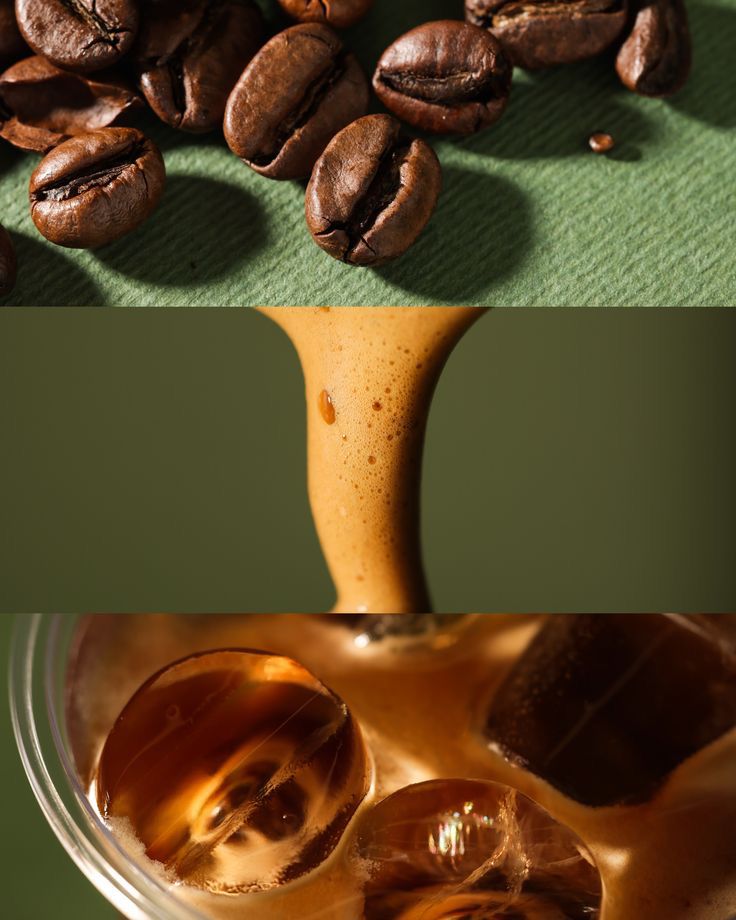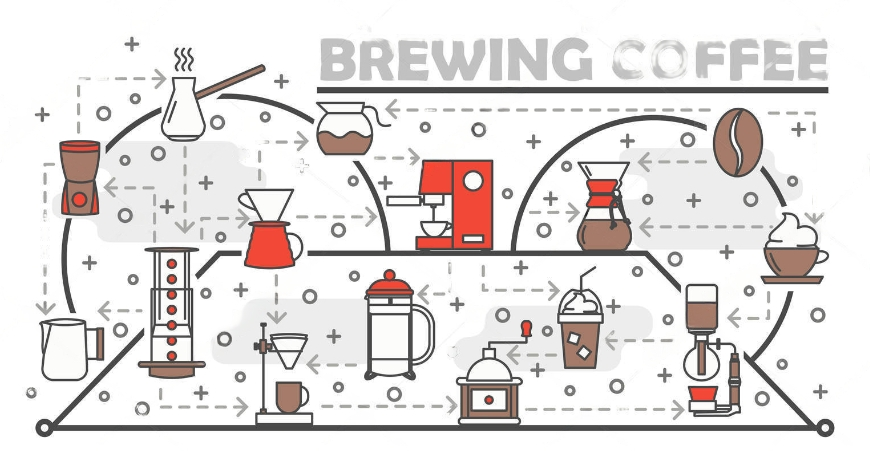I. Introduction
Coffee brewing is an art form, with countless methods available to bring out the best flavor in your cup of java. Whether you are a coffee enthusiast or a café owner, having a basic understanding of different brewing techniques can help you tailor your brew to your tastes and preferences. In this article, we will explore five popular coffee brewing methods—from French presses and drip makers to pour-overs and cold brews—so that you can find the perfect one for you.
A. Importance of coffee brewing
Brewing coffee is more than just a way to make your morning cup; it's an opportunity to unlock the full potential of your beans and discover unique flavors hidden within them. Crafting your coffee allows you to be creative and experiment with different brewing methods, adding elements like temperature, time, and grind size to customize your perfect blend. Coffee brewing isn't just about making a great cup of joe - it's about unlocking the flavor profiles of high-quality coffee beans and discovering something new in each cup.
B. The science behind coffee brewing
Making a great cup of coffee requires more than just the right ingredients and a reliable brewing device; it also requires an understanding of the science behind coffee brewing. Many variables come into play as you craft your perfect cup, including water temperature, grind size, contact time, and agitation; all of these factors affect how the coffee extracts from the beans, determining the flavor profiles and body of your final brew. Knowing the basics of extraction and flavor can help you refine your process to create even better blends each time.
C. Overview of different coffee brewing methods
Coffee lovers have a variety of methods available to brew the perfect cup. Each technique offers its unique flavor profiles, body, and strength, allowing for endless experimentation. Some of the most popular methods include pour-over, French press, cold brew, espresso, and Aeropress. Understanding the basics of each method can help you determine which brewing device best suits your needs and preferences. With the right knowledge and practice, you can unlock your inner barista and craft an immersive coffee experience like no other.
II. Drip coffee brewing
A. Definition and process
Drip coffee brewing is one of the most common methods of making coffee. It involves pouring hot water over ground coffee beans placed in a filter, which then allows it to drip through into a carafe or mug. This method offers an easy and reliable way to produce a balanced cup of coffee with minimal effort. To make sure you get the best taste from your cup, variables such as water temperature, grind size, contact time, and agitation can be adjusted. Whether you use an automatic brewer or go for manual pour-over equipment, drip coffee remains one of the favorites for brewing a great cup of coffee.
B. Pros and cons
Drip coffee brewing is a great way to make coffee for those who want an easy and reliable method. The process has a relatively low cost and can also easily be outsourced to automated machines. Moreover, it gives you the ability to control certain variables such as water temperature, grind size, contact time, and agitation. On the other hand, not all drip brewers are created equal; they might require extra skills and knowledge to get the best out of them. They also require more initial setup than other methods, such as French press or espresso. Overall, for anyone looking for a balanced cup of coffee, drip brewing is an ideal option.
C. Variations: automatic drip, pour-over
The two main types of drip coffee brewing are automatic and pour-over. Automatic drip coffeemakers use a paper filter to brew the coffee, with adjustments made to water temperature, grind size, contact time, and agitation. On the other hand, pour-over requires you to manually pour hot water over a bed of ground beans in a filter. Both methods have their advantages and disadvantages; many people opt for one or the other based on their preferences. Demands such as speed and flavor can determine which approach you take when it comes to brewing your cup of joe.
III. French press brewing
A. Definition and process
French press brewing—also known as a "plunger pot" or "cafetière"—is a method of manually making coffee that requires hot water and coarsely ground beans. In this process, the hot water is poured into the French press pot and stirred with a plunger before being placed in the refrigerator for several minutes to allow it to steep. When the desired strength has been achieved, the plunger is pushed down to separate the grounds from the coffee. This results in a full-bodied cup of coffee with strong flavor notes due to its increased contact time with the grounds.
B. Pros and cons
French press coffee brewing offers several benefits to people who are looking for a robust, flavorful cup of coffee. It is easy to use, requires minimal equipment, and produces a rich, full-bodied cup that has retained its natural oils. Additionally, since the grounds are filtered out after steeping, this method allows one to enjoy multiple cups without having to change the filter each time. On the downside, French press coffee takes longer to prepare than other methods and can be quite difficult to clean afterward. Additionally, it requires coarsely ground beans which can be hard to find in some areas. Finally, due to its slow filtration process, sediment can often make its way into your cup of coffee as a result.
C. Variations: Aeropress, Moka pot
The French press brewing method has several variations, each with its own set of advantages and disadvantages.
Aeropress is a simpler version of French Press coffee brewing; it uses a plastic or metal cup to hold the coffee, a filter, and a plunger to press it down. This cup is placed above an empty mug and the coffee is then pushed through the filter with the plunger. This method produces a less bitter cup of coffee due to its shorter contact time with the grounds, but still retains much of the flavor notes.
Moka Pot: The Moka pot is an espresso-style alternative to the French press that uses steam pressure to force hot water through finely-ground coffee beans. This quick process results in a stronger-tasting cup of coffee than other manual methods. However, as it requires constant attention for safety reasons, this method may be more suitable for experienced coffee makers.
IV. Espresso brewing
A. Definition and process
Espresso is a type of coffee that is brewed using pressure to produce a concentrated and full-bodied flavor. The process begins by grinding the beans into a fine powder and packing it tightly into a portafilter for an espresso machine. Hot water at high pressure is then forced through the portafilter, resulting in a small cup of espresso with an intense aroma and taste.
This method requires precise measurements, as too little ground coffee can lead to a weak cup while too much will result in an over-extracted and bitter cup. Additionally, the water must be heated precisely to achieve the desired effect. For this reason, espresso brewing is best suited for experienced baristas or those willing to put in the time to perfect their skills.
B. Pros and cons
Pros:
- It produces a rich, flavorful cup of coffee;
- the process is quick and requires little hands-on time;
- it can also be used to make other types of drinks such as cappuccinos and lattes.
Cons:
- Requires precise measurements and techniques for optimal results
- High start-up cost with expensive espresso machines required
- Must be closely monitored while brewing due to the high pressure involved
C. Variations: Ristretto, Lungo, Americano, Latte, Cappuccino
Ristretto: A short shot of espresso that uses the same amount of coffee, but half the amount of water as used in a traditional espresso. It results in an intense flavor with little to no crema.
Lungo: A lungo is a long shot of espresso that uses twice as much water as a normal shot, producing a lighter, less-concentrated cup with more crema than a ristretto.
Americano: An Americano is made by diluting an espresso with hot water to create a milder cup that has more body and flavor than regular drip coffee.
Latte: A latte is made by combining two shots of espresso with steamed or foamed milk, resulting in a creamy drink with strong espresso flavors.
Cappuccino: A cappuccino is similar to a latte; however, it consists of one part espresso, one part steamed or foam milk, and one part foamed milk. The addition of the foamed milk gives it a thicker texture than the latte and makes for an ultra-creamy drink.
V. Cold brewing
A. Definition and process
Cold-brewing coffee is a method of making coffee that involves steeping the beans in cold or room-temperature water over an extended period. The result is a smooth, mellow cup with less acidity than hot-brewed coffee. The process is surprisingly simple and requires minimal effort: all you need to do is grind coarsely ground fresh beans, add cold or room-temperature water, and let it steep in your fridge overnight or up to two days. When the steeping time is complete, you will have a wonderfully smooth and rich concentrate that can be enjoyed as-is or diluted with hot water to make a regular cup of joe. Enjoy!
B. Pros and cons
Cold-brewing coffee is an easy and delicious way to make a cup of joe. Here are the pros and cons of this method:
Pros:
- Cold-brewed coffee is less acidic than hot-brewed coffee, making it easier on the stomach.
- Its slow extraction process produces a smooth flavor and it can be stored in the fridge for up to two weeks, so you always have a refreshing cup on hand.
- Making a batch requires minimal effort - just add cold water to coarsely ground coffee beans and let it steep overnight!
Cons:
- It takes longer to prepare than hot-brewed coffee—typically 12–15 hours for a good batch.
- Coarsely-ground beans need to be used for optimal results; if you don't have the right grind size available, it may not yield the best results.
Overall, cold brewing is an excellent way to enjoy delicious coffee without much fuss. Give it a try today and find out why so many people swear by this method!
C. Variations: Iced coffee, Nitro cold brew
Cold-brewing coffee is a popular method for making a delicious cup of joe, and there are several variations to explore. Here are two of the most popular ways to enjoy cold-brewed coffee: Iced Coffee and Nitro Cold Brew.
Iced Coffee
Iced coffee is simply cold-brewed coffee that has been diluted with more water or milk and served over a bed of ice. This variation is great for hot summer days when you still want to enjoy your favorite beverage without having to grapple with the heat.
Nitro Cold Brew
Nitro cold brew, on the other hand, is cold-brewed coffee infused with nitrogen gas. The result is a creamy, smooth, and sweet cup that looks like Guinness beer on tap. It's worth trying out if you're looking for something new!
VI. Turkish coffee brewing
A. Definition and process
Turkish coffee is a type of brew that has been enjoyed for centuries. It is made by boiling finely ground coffee in a small pot with the addition of sugar and spices such as cardamom or cinnamon. The result is an incredibly strong, full-bodied cup of coffee that packs a flavorful punch! Preparing Turkish coffee involves the following steps:
- Start by bringing one cup (8 ounces) of cold water to a boil in a small pot on medium heat.
- When the water begins to boil, add two tablespoons of finely ground coffee and stir quickly until all grounds are wet and evenly distributed in the mix.
- Lower the heat and allow the mixture to simmer for about 5 minutes while foam forms at the top - this indicates that your mixture is ready for the next step.
- Add two teaspoons of sugar (or more, depending on your preference) and give it another quick stir until everything is combined nicely. Turn off the heat and let it sit for 5-10 minutes so that any sediment can settle at the bottom of the pot before serving.
- Carefully pour into cups so as not to disturb any sediment that has reached the bottom; add cream or milk if desired and enjoy!
B. Pros and cons
Turkish coffee has many benefits, but it also has some drawbacks. Below are the pros and cons of this particular brewing method:
Pros
- A strong, flavorful cup of coffee that packs an amazing flavor kick
- The quick and easy brewing process
- Can be tailored to individual preferences with the addition of different spices or levels of sweetness
- Unlike other methods, no extra equipment is required for brewing Turkish coffee - all you need is a small pot!
Cons
- Requires regular stirring and attention during the brewing process to prevent boiling over or burning the grounds
- Unfiltered form of coffee may be higher in caffeine content than other types
- Sediment from grounds left at the bottom of each cup when served
C. Variations: Greek coffee
Greek coffee is a type of traditional brew that is closely related to Turkish coffee but with a few important differences. It uses the same method of boiling finely ground coffee in a pot with sugar and spices, but typically requires more grounds per cup and has a higher foam-to-coffee ratio. Greek coffee also tends to be less sweet than Turkish and can take anywhere from five to fifteen minutes to preparation. Because of this difference, it develops different flavor notes compared to its Turkish counterparts, such as nutty undertones or smoky aromas!
VII. Conclusion
A. Recap of different brewing methods
After discussing the different coffee-brewing methods, such as drip coffee, French press, espresso, cold brew, and Turkish coffee; it is clear that everyone can find a perfect cup of joe for them. No matter which method they decide on, each offers its unique flavor profiles and complexities. Whether they prefer a classic French press or something more modern like an espresso shot, there are plenty of options to choose from to create their favorite cup every morning!
B. Factors to consider when choosing a brewing method
When choosing the best brewing method for you, it is important to consider your preferences and lifestyle. Do you prefer a stronger brew or something more subtle? Do you have the time for a slow and long extraction process, or do you need something that can be done quickly? Lastly, consider the cost of each method; some require additional equipment, such as an espresso machine or French press. By taking all of these factors into account, you can choose the ideal coffee brewing method for you!
C. Final thoughts and recommendations.
To wrap up, there are many different methods for brewing coffee that all offer unique aromatic and flavor profiles. However, whichever method you decide to use, it is important to take into account the time, cost, and effort of each method before settling on one. With that said, the true beauty of coffee lies in its ability to be experimented with! So don't be afraid to try out different methods and find your perfect cup—the possibilities are endless!
VI. Additional Resources
A. Recommended coffee brand
For those looking for the best coffee brands and brewing methods to make the most of their daily cup of Joe, visit our shop for a great coffee experience. We also have coffee machines, grinders and brewing tools.
B. Online communities and forums for coffee lovers
For those looking for an online community to share their coffee experiences and knowledge with others, these are some of the best options.


